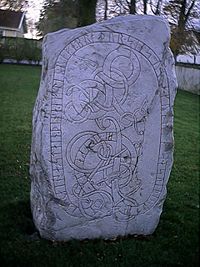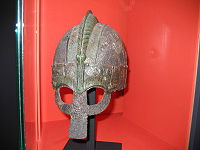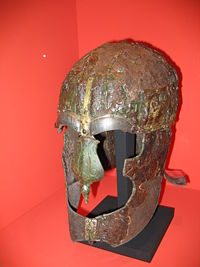Swedes (Germanic tribe)
The Swedes (Swedish: svear; Old Norse: svíar; Old English: Sweonas; Latin: Suiones, Suehans or Sueones) were an ancient North Germanic tribe in Scandinavia. As the dominions of their kings grew, their land slowly evolved into the modern Swedish nation.
According to early sources, such as the Norse sagas, and especially Heimskringla, the Swedes were a powerful tribe whose kings claimed descendence from the god Freyr. During the Viking Age they constituted the basis of the Varangian subset, the Vikings that travelled eastwards (see Rus').
Their privileged position within the Swedish kingdom was abolished in the mid-13th century.[1] Until then, the Swedes had had semi-aristocratic status being only obliged to provide the King of Sweden with ships, warriors and their provisions during wars, whereas other nations within the kingdom, such as Geats and Gotlanders were tributary nations who were regularly taxed.[1]
Contents |
On the name
As the dominions of the Swedish kings grew, the name of the tribe could be applied more generally during the Middle Ages, to include the Geats. Later it returned to referring only the people inhabiting the original tribal lands in Svealand, in opposition to the Geats.
In modern Scandinavian, the adjectival form svensk and its plural svenskar have replaced the name svear and is, today, used to denote all the citizens of Sweden. The distinction between the tribal Swedes (svear) and modern Swedes (svenskar) appears to have been in effect by the early 20th century, when Nordisk familjebok noted that svenskar had almost replaced svear as a name for the Swedish people.[2] Although this distinction is convention in modern Norwegian, Danish and Swedish, Icelandic retains the traditional terminology and call both Svíar.
Location
Their primary dwellings were in eastern Svealand, i.e. the traditional Folklands of Attundaland, Tiundaland, Fjärdhundraland and Roslagen in the area of the present cities of Uppsala and Stockholm and the modern province of Gästrikland. Their territories also very early included the provinces of Västmanland, Södermanland and Närke in the basin of Mälaren which constituted a bay with a multitude of islands. The region is still one of the most fertile and densely populated regions of Scandinavia.
Their territories were called Svealand (the Voyage of Ohthere: Swéoland), Suithiod (Beowulf: Sweoðeod), Svíaveldi or Svea rike (Beowulf: Swéorice), and the unknown moment when they subjugated, or united politically with, the Geats in Götaland, sometime between the 6th century and the 11th century is nowadays often regarded as the birth to the Swedish kingdom, although the Swedish kingdom is named after them, Sverige in Swedish, from Svea rike - i.e. the kingdom of the Suiones. The English name Sweden is derived from an old name for Sweden and the land of the Suiones: Sweoðeod (the people of the Suiones).
The Ásatrú Aesir-cult centre in Gamla Uppsala, was the religious centre of the Swedes and where the Swedish king served as a priest during the sacrifices (blóts). Uppsala was also the centre of the Uppsala öd, the network of royal estates that financed the Swedish king and his court until the 13th century.
Some dispute whether the original domains of the Suiones really was in Uppsala, the heartland of Uppland, or if the term was used commonly for all tribes within Svealand, in the same way as old Norway's different provinces were collectively referred to as Nortmanni.
Etymology
The form Suiones appears in the Roman author Tacitus's Germania. A closely similar form, Sweon(as), is found in Old English and in the work of Adam of Bremen about the Hamburg-Bremen archbishops who are denoted Sueones.
According to one theory (Schagerström 1931), the name is derived from Proto-Germanic *saiwi- meaning "lake" or "sea" resulting in *siwíoniz and later *swi-oniz meaning the "sea people". However, this root is not known to have produced any other derived names, and is considered unlikely.
Noréen (1920) proposed that Suiones is a Latin rendering of Proto-Germanic *Swihoniz, meaning "one's own (tribesmen)", derived from the same Proto-Indo-European root as the Latin suus (i.e. not from Latin but from the same reflexive pronominal root, a root also existing in Slavic languages). In modern Scandinavian, the same root appears in words such as svåger (brother-in-law) and svägerska (sister-in-law). The form *Swihoniz would in Wulfila's Gothic become *Swaíhans, which later would result in the form Suehans that Jordanes mentioned as the name of the Swedes in Getica. Consequently, the Proto-Norse form would have been *Swehaniz which following the sound-changes in Old Norse resulted in Old West Norse Svíar and Old East Norse Swear. However, this root has not gained wide acceptance, which leads to the oldest theory of which the proposed root is widely accepted.
According to a third theory (v. Friesen 1915), it is not derived from the root *swih, but from the root *Swe and being originally an adjective, Proto-Germanic *Sweoniz, meaning "kindred". Then the Gothic form would have been *Swians and the H in Suehans a pleonasm. The Proto-Norse form would then also have been *Sweoniz which also would have resulted in the historically attested forms.

Although, scholars differ on the origins of the name, they agree that Suiones is the same name as Old Norse svíar and Old English Sweon(as). Even though the n has disappeared in the plural noun svear/svíar, it is still preserved in the old adjective which has become the noun designating modern Swedes: svensk.
The name became part of a compound, which in Old West Norse was Svíþjóð, (The Suione People), in Old East Norse Sweþiuð and in Old English Sweoðeod. This compound appears on runestones in the locatives i suiþiuþu (Runestone Sö Fv1948;289, Aspa Löt, Sörmland), a suiþiuþu (Runestone DR 344, Simris, Skåne) and o suoþiauþu (Runestone DR 216, Tirsted, Lolland). The 13th century Danish source Scriptores rerum danicarum mentions a place called litlæ swethiuthæ, which is probably the island Sverige (Sweden) near Stockholm. The earliest instance, however, appears to be Suetidi in Jordanes' Getica (6th century).
The only Germanic nation having a similar naming was the Goths, who from the name *Gutans (cf. Suehans) created the form gut-þiuda.
The name Swethiuth and its different forms gave rise to the different Latin names for Sweden, Suethia, Suetia and Suecia as well as the modern English name for the country.
A second compound was Svíariki, or Sweorice in Anglo-Saxon, which meant "the realm of the Suiones". This is still the formal name for Sweden in Swedish, Svea rike and the origin of its current name Sverige with the "k" in the old form "Sverike" changed to a "g" through Danish influence. In contemporary Latvian the word zviedri means "Swedes" and the word Zviedrija (originating from Svea rike) is the name for Sweden, showing the very old relations between the ancestors of Swedes and Latvians since the first scandianavian settlements in Grobiņa and Apuole in 6th century AD.
History
The history of this tribe is shrouded in the mists of time. Besides Scandinavian mythology and Germanic legend, only a few sources describe them and there is very little information, in spite of the fact that the tribe existed already during the first century A.D.
Romans

There are two sources from the 1st century A.D that are quoted as referring to the Suiones. The first one is Pliny the Elder who said that the Romans had rounded the Cimbric peninsula (Jutland) where there was the Codanian Gulf (Kattegat?). In this gulf there were several large islands among which the most famous was Scatinavia (Scandinavia). He said that the size of the island was unknown but in a part of it dwelt a tribe named the Hillevionum gente, in 500 villages, and they considered their country to be a world of its own.
What strikes the commentators of this text is that this large tribe is unknown to posterity, unless it was a simple misspelling or misreading of Illa Svionum gente. This would make sense, since a large Scandinavian tribe named the Suiones was known to the Romans.
Tacitus wrote in AD 98 in Germania 44, 45 that the Suiones were a powerful tribe (distinguished not merely for their arms and men, but for their powerful fleets) with ships that had a prow in both ends (longships). Which kings (kuningaz) ruled these Suiones is unknown, but Norse mythology presents a long line of legendary and semi-legendary kings going back to the last centuries BC.
After Tacitus' mention of the Suiones, the sources are silent about them until the 6th century as Scandinavia still was in pre-historic times. Some historias have maintained that it is not possible to claim that a continuous Swedish ethnicity reaches back to the Suiones of Tacitus[3]. According to this view the referent of an ethnonym and the ethnic discourse have varied considerably during different phases of history.
Jordanes

In the 6th century Jordanes named two tribes he calls the Suehans and the Suetidi who lived in Scandza. The Suehans are considered to be the Suiones, and they were famous for their fine horses. Snorri Sturluson wrote that the contemporary Swedish king Adils (Eadgils) had the finest horses of his days. The Suehans were the suppliers of black fox skins for the Roman market. Then Jordanes names a tribe named Suetidi a name that is considered to refer to the Suiones as well and to be the Latin form of Sweþiuð. The Suetidi are said to be the tallest of men together with the Dani who were of the same stock.
Anglo-Saxon sources
There are three Anglo-Saxon sources that refer to the Swedes. The earliest one is probably the least known, since the mention is found in a long list of names of tribes and clans. It is the poem Widsith from the 6th or the 7th century:
|
|
On line 32, Ongentheow is mentioned and he reappears in the later epic poem Beowulf, which was composed sometime in 8th, 9th and the 10th centuries.

The poem describes Swedish-Geatish wars, during the 6th century, involving the Swedish kings Ongentheow, Ohthere, Onela and Eadgils who belonged to a royal dynasty called the Scylfings. These kings were probably historical kings as they appear in many Scandinavian sources as well (see Swedish semi-legendary kings). There appears to be a prophecy by Wiglaf in the end of the epic of new wars with the Swedes:
|
|
When more reliable historic sources appear the Geats are a subgroup of the Swedes.
The third Anglo-Saxon source is Alfred the Great's translation of Orosius' Histories, where are told the voyages of Ohthere from Hålogaland and Wulfstan of Hedeby, who in the 9th century described the Sweon and Sweoland.
Ohthere's account is limited to the following statement about Swēoland:
- Ðonne is toēmnes ðǣm lande sūðeweardum, on ōðre healfe ðæs mōres, Swēoland, oð ðæt land norðeweard; and toēmnes ðǣm lande norðeweardum, Cwēna land.(Excerpt presented by the University of Victoria
- Then Sweden is along the land to the south, on the other side of the moors, as far as the land to the north; and (then) Finland (is) along the land to the north.(Translation of the University of Victoria
Wulfstan only mentions a few regions as being subject to the Sweons (in translation):
- Then, after the land of the Burgundians, we had on our left the lands that have been called from the earliest times Blekingey, and Meore, and Eowland, and Gotland, all which territory is subject to the Sweons; and Weonodland was all the way on our right, as far as Weissel-mouth.[1]
Frankish sources
During the 8th century and 9th century Suione traders and raiders settled in the north of eastern Europe, a country of rivers and Baltic, Slavic and Finnish tribes.
The Annales Bertiniani relate that a group of Vikings, who called themselves Rhos visited Constantinople around the year 838. Fearful of returning home via the steppes, which would leave them vulnerable to attacks by the Magyars, these Rhos travelled through Germany. They were questioned by the Frankish Emperor Louis the Pious somewhere near Mainz. They informed the emperor that their leader was known as chacanus (the Latin for "Khagan") and that they lived in the north of Russia, but that they were Sueones.
Adam of Bremen
Dealing with Scandinavian affairs, Adam of Bremen relates in the 11th century that the Sueones had many wives and were severe on crime. Hospitality was an important virtue and refusing a wanderer to stay over the night was considered shameful. The visitor was even taken to see the hosts' friends.
It is interesting that even if 1000 years separate Adam of Bremen from Tacitus both describe the Suiones as being composed of many tribes, probably identical to the traditional provinces of eastern Svealand. Like Tacitus, he also notes that they are powerful warriors at sea, a power that they use to keep their neighbours in order. Their royal family is of an old dynasty (see House of Munsö), but the kings are dependent on the will of the people (the Ting). What has been decided by the people is more important than the will of the king unless the king's opinion seems to be the most reasonable one, whereupon they usually obey. During peacetime, they feel to be the king's equals but during wars they obey him blindly or whoever among them that he considers to be the most skillful. If the fortunes of war are against them they pray to one of their many gods (Aesir) and if they win they are grateful to him.
Norse sagas
The Norse sagas are our foremost source for knowledge and especially Snorri Sturluson who is probably the one who has contributed the most (see for instance the Heimskringla). His descriptions concur to a large extent with those of the previous sources.
For a continuation, see Early Swedish History.
Notes and references
Sources
- Larsson, Mats G (2002). Götarnas Riken : Upptäcktsfärder Till Sveriges Enande. Bokförlaget Atlantis AB ISBN 9789174866414
See also
- Mythical kings of Sweden
- Semi-legendary kings of Sweden
- Swedish people
- Svea
- Mother Svea
- Trial by combat
- Trial by ordeal
|
||||||||||||||||||||||||||||||||
